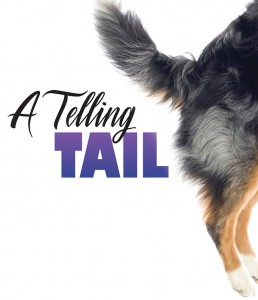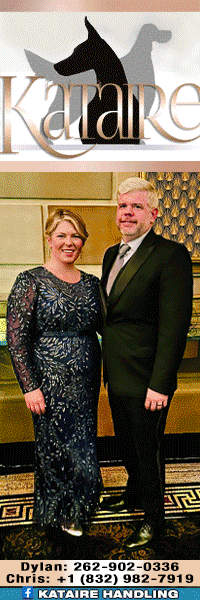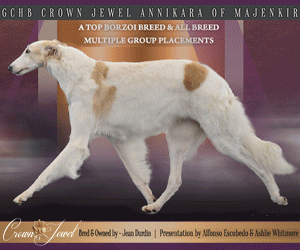A Telling Tail
Click here to read the complete article
466 – November/December 2019
 By William Given
By William Given
“So, just what is the big deal,” he says to a friend after getting fourth place in a class of four, “if my dog’s tail resides an inch further down the croup than that of the other dogs in the ring? It is a handsome tail, it looks to me to be the right sort of tail, and it seems to suit him quite nicely.” And, believe it or not, he may very well be more accurate than he realizes.
A poorly set-on tail can look good on a dog, and this is because the dog with this fault very rarely has correctly constructed hindquarters. This is one of the aspects of dog show judging which easily perplexes newcomers to the game, particularly when they discover that the tail of their much beloved ring partner is not joined to his body in quite the manner which the breed standard prescribes as being correct.
We must remember that the tail is not just something that is stuck on at the end of the dog. It is the “caudal terminal appendage of the spinal column.” The normal, undocked tail of a dog consists of 23 vertebrae. These highly mobile vertebrae are encased in a bundle of connective tissue, nerves and muscles, and they make the tail capable of both gross and fine movements.
From this, it is natural that where a tail is poorly set-on, the dog commonly moves in an incorrect manner going away and from the side. Of course, it is not the poorly set-on tail that is adversely affecting the movement. As a result of not being properly constructed, the dog would move inadequately in any case. The poorly set-on tail simply focuses attention to this fact.
Let us take a quick look at a dog which we shall call the High Plains Silhouette Hound. The breed standard says, “the tail should be thick at the base and taper toward the tip, the tip of the tail should not reach the hock.” The standard further stating, “The tail should be set-on at the level of the topline.” Now, this, I think, should be interpreted as meaning that the tail should join the body at the same height as the level of the topline. My very imperfect illustration (Figure 1) should give you the general idea.
If we take some time to observe the movement of the dog portrayed in Figure 1, and I am talking of that most important movement which is viewed from the side, one would expect to see this dog really driving with his hind legs. That is, placing his hind feet well under him and driving forward, thrusting each pad well behind him before he picks it up again. The hind legs are not an accessory; they are the dog’s primary means of achieving increased velocity.
Variations, and there are many, of the same tail, but set on too far back–and in a great many breeds, too far back often means too low.
 In Figure 2, we see that it is not just the tail which is wrong, but it is accompanied with faulty hindquarters. The tail is simply a semaphore which signals, “When I move, I must keep my legs tucked under me and will only cover a limited amount of ground with each stride I take.”
In Figure 2, we see that it is not just the tail which is wrong, but it is accompanied with faulty hindquarters. The tail is simply a semaphore which signals, “When I move, I must keep my legs tucked under me and will only cover a limited amount of ground with each stride I take.”
Since this is not an article on the conformation of the High Plains Silhouette Hound, we will move along, but before we do, I invite you to imagine a low set tail on the dog in Figure 1. Have you ever seen such an animal? I am going to guess not and it is unlikely you will.
Now, try to imagine the dog in Figure 2 with correct hindquarters under a low set-on tail. You may not be able to, and that is okay because the two are truly incompatible. Correct tails and well-constructed hindquarters are factors in the same equation.
Let us look at another example, the Greyhound. The Greyhound is a dog built for speed and his tail serves as a counterbalance thereby increasing his agility and ability to successfully make quick turns at great speeds. Remember, that the tail is the natural extension of the vertebral column and continues straight on, and is carried on the same line, so his tail should be set low and carried low. If it were high-set, or even carried gaily, it could only mean that the dog’s back was too level. Therefore, the animal would not have the correct arch over the loin or the typical down-swept hind quarters.
It is not only the set-on of the tail that is important. Every breed has something quite unique about its tail and it is almost true to say that no two breeds have precisely the same tail. Some, such as the otter-tail of the Labrador or the ring tail of the Afghan, are particularly distinguishing. But even with other breeds there is always something to differentiate it, even if it has been docked.
For example, both the Airedale and the Kerry Blue have a tail that is set-on high, docked and carried erect, but each are unmistakably different. The Basenji and the Pug have a tail that is curled and carried over the back, but one would never mistake one for the other. Some tails are thick like that of the German Shepherd Dog, some are very thin like that of the Bedlington, and some tails are plumed like that of the Irish Setter.
Water retrievers, like the Chesapeake Bay Retriever, have strong tails that are noticeably thicker and heavier at the base. They use their tails as a rudder which helps them move more easily through the water. Nordic breeds, like the Samoyed, have busy tails with dense hair. When lying down in cold weather they often pull their tails up over their faces.
Not All Dogs Have a Tail
Some breeds, mostly those that herd, are born with a rudimentary tail. This may be little more than a flap of fatty tissue. For example, many Australian Shepherds are born without tails. The fatty tissue will have hair on the end, and their wiggling butt will pretty much let you know just what going on in their head. The tail that I find to be the most unique is that of the Irish Water Spaniel. At the root, his tail is thick and covered for two or three inches with short curls. It tapers to a fine point and from the root curls it is covered with short, smooth hair.
Tail Carriage is Unique
And, apart from the difference in appearance, there is, also, the distinctive way in which they all carry their tails. Once again, nearly every breed has a different style or manner of carriage. The one thing they all have in common is the fact that, unless the different breeds are carrying their tails correctly, they all look wrong.
Crucial Tool in Canine Communication
A dog’s tail is an essential element of its communication system. They express aggression, stress, happiness and many other emotions with their tail, and we can learn a great deal about what our canine companions are feeling by watching their tail. When a dog holds his tail high and wags it back and forth, he is certainly feeling pretty happy. When a dog is interested or focused on something, the dog holds his tail horizontal to the ground. If the tail goes from horizontal to upright and should become rigid, you can assume the dog is feeling threatened or has possibly been challenged. And, should the tail be held low, the dog is likely feeling insecure.
Takeaway Message
I have been in the sport a long time now, yet not nearly as long as some of you, and I know you would like writers to be entertaining or informative…and both when possible. In a perfect world, I should be able to finish this article by telling you what can be done with a tail that is not quite as correct as it should be.
However, our world is imperfect, and so is some of our breeding practices. Therefore, I can only caution you to be wary of any type of tail that is not typically characteristic of your breed. Consider carefully the use of any animal with a poorly set-on tail in your breeding program. Always remember that like produces like. A poorly set-on tail is the result of recessive genes and even if not all puppies in a litter are born with a poorly set-on tail, all puppies in the litter will carry the gene for the condition. No amount of wishful thinking will ever alter this abiding law of Mother Nature.
The dog wags its tail to show pleasure or as an invitation to come for a walk or to play. It can be lowered as part of an aggression display, or tucked under in fear or submission. Apart from its use as a tool of communications, the tail has physical uses.
Click here to read the complete article
466 – November/December 2019
Short URL: http://caninechronicle.com/?p=174457
Comments are closed











